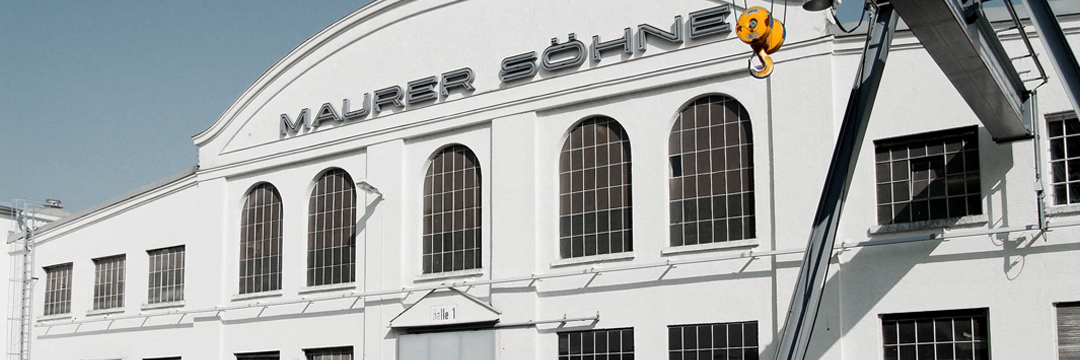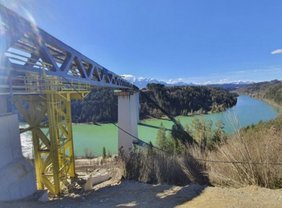
Bearings Slid in Piggyback

Jauntal Bridge, Carinthia. In future, the new railway bridge over the Drava River in Carinthia, Austria, will function with a unique combination of sliding isolation pendulums and brake dampers. For slow and continuous movements, the load-bearing structure slides over the bearings with almost no resistance. When a train brakes or starts, specific brake dampers hold the bridge in place. The re-centring sliding isolation pendulums then allow the bridge to slide back again into its original position. This special combination was proposed by MAURER as a system solution.
The Jauntal Bridge will be modernised and a second track laid during the construction of Koralm Railway. The 96-metre-high and 430-metre-long railway bridge over the Drava River is one of the highest railway bridges in Europe and will become operational again by the end of 2023.
The new composite structure has two tracks on top and a foot and cycle path below. The two piers in the slope and both piers in the river erected as early as 1961 have been preserved. Preliminary investigations revealed that – following minor repair measures – they can still be used for vertical load transmission. However, they must not be used for horizontal load transmission resulting from braking and starting.
At that point, MAURER was able to contribute its expertise in structural protection and jointly developed a unique overall package of re-centring bridge bearings (Sliding Isolation Pendulums SIP®) and fast-acting brake dampers (Shock Transmission Units STU) with the parties involved. All bearings and dampers fulfil the required technical service life of at least 50 years and the lowest possible coefficient of sliding friction of maximum 2 %. The steel structure of the new bridge was manufactured in three segments on site at the pre- assembly place. The first segment was then connected to the existing bridge. In that way, the new bridge was slid in and the old bridge slid out segment by segment in the longitudinal direction.
Subtle interaction
The new bearing system in the longitudinal direction required a holistic view and precise coordination of the main components of the bridge’s horizontal system: sliding isolation pendulums, brake dampers and carriageway expansion joints. The longitudinal displacements of the load-bearing structure owing to the monotonously and gradually increasing load conditions (such as constant temperature changes in the structure) must take place without remarkable resistance and significant response force in the brake damper. At the same time, longitudinal movements of the structure have to be prevented during jerky braking and starting processes. This can be done through fast-acting brake dampers in the area of the abutment, which transfer the braking and starting forces into the abutments and the ground.
Re-centring sliding isolation pendulums
Two sliding isolation pendulums SIP® were installed in each pier and two spherical bearings with a flat sliding surface in each abutment. Sliding isolation pendulums have a curved sliding surface that is specifically selected and adjusted to the specific application. This curvature creates a re-centring effect and enables the system to slide back to its original position after deflection. With this floating support, the bridge automatically aligns itself centrally at all times.
Lowest possible friction coefficients
It was especially important that all bearings featured lowest possible friction coefficients so that the historic piers are loaded as little as possible. In order to meet the quality requirements in terms of the high sliding and load-bearingcapacity as well as the long technical service life of at least 50 years, all bearings were equipped with wear-resistant sliding materials MSM® (MAURER Sliding Material) combined with corrosion-resistant calottes MSA® (MAURER Sliding Alloy). For superimposed loads of up to 52 MN, it was possible to design relatively compact bearings with a weight of up to 2,500 kg and dimensions of up to 1,300 x 1,234 mm.
For installation, the SIP® bearings were placed on the load-bearing structure and transported to the respective piers with the launching. After the new bridge had been completely launched, the bearings were lowered to the installation site using specific mounting girders and installed in the bearing plinths. The alignment and lowering of the load-bearing structure and its positioning on the final spherical bearings and sliding isolation pendulums took place in May 2023.
The dampers and carriageway expansion joints at both ends of the bridge will be installed in summer 2023. The bridge is scheduled to become operational along with the timetable change in December 2023.
“The realisation of such innovative ideas requires a high level of implementation competence and responsibility”, emphasises Dr Saeed KARIMI, Head of the MAURER subsidiary in Austria. “We would therefore also like to thank all our partners for realising this challenging project.” In detail, these were:
- Client: ÖBB Infrastruktur AG
- Structural designer: KOB ZT GmbH
- Substructure planner: ZKP ZT GmbH
- Consortium of test engineers: KMP ZT GmbH & Baumann + Obholzer ZT GmbH
- Execution of construction work: ARGE Jauntalbrücke (SWIETELSKY AG and Donges SteelTec GmbH)
Merkez İletişim
MAURER SE
Frankfurter Ring 193
80807 Münih
Almanya
Telefon +49. 89. 32394-0
E-posta







